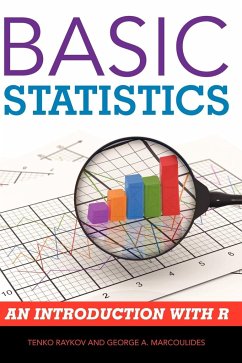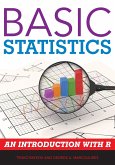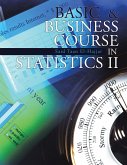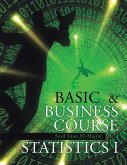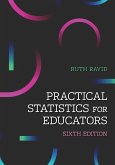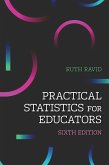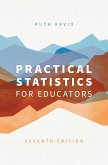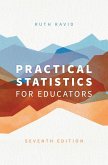- Gebundenes Buch
- Merkliste
- Auf die Merkliste
- Bewerten Bewerten
- Teilen
- Produkt teilen
- Produkterinnerung
- Produkterinnerung
Basic Statistics provides an accessible and comprehensive introduction to statistics using the free, state-of-the-art software program R. This book is designed to both introduce students to key concepts in statistics and to provide simple instructions for using the powerful software program R.
Andere Kunden interessierten sich auch für
![Basic Statistics Basic Statistics]() Tenko RaykovBasic Statistics104,99 €
Tenko RaykovBasic Statistics104,99 €![Basic & Business Course in Statistics II Basic & Business Course in Statistics II]() Said Taan El-HajjarBasic & Business Course in Statistics II113,99 €
Said Taan El-HajjarBasic & Business Course in Statistics II113,99 €![BASIC & BUSINESS COURSE IN STATISTICS I BASIC & BUSINESS COURSE IN STATISTICS I]() Said Taan El-HajjarBASIC & BUSINESS COURSE IN STATISTICS I112,99 €
Said Taan El-HajjarBASIC & BUSINESS COURSE IN STATISTICS I112,99 €![Practical Statistics for Educators Practical Statistics for Educators]() Ruth RavidPractical Statistics for Educators67,99 €
Ruth RavidPractical Statistics for Educators67,99 €![Practical Statistics for Educators Practical Statistics for Educators]() Ruth RavidPractical Statistics for Educators129,99 €
Ruth RavidPractical Statistics for Educators129,99 €![Practical Statistics for Educators Practical Statistics for Educators]() Ruth RavidPractical Statistics for Educators56,99 €
Ruth RavidPractical Statistics for Educators56,99 €![Practical Statistics for Educators Practical Statistics for Educators]() Ruth RavidPractical Statistics for Educators135,99 €
Ruth RavidPractical Statistics for Educators135,99 €-
-
-
Basic Statistics provides an accessible and comprehensive introduction to statistics using the free, state-of-the-art software program R. This book is designed to both introduce students to key concepts in statistics and to provide simple instructions for using the powerful software program R.
Hinweis: Dieser Artikel kann nur an eine deutsche Lieferadresse ausgeliefert werden.
Hinweis: Dieser Artikel kann nur an eine deutsche Lieferadresse ausgeliefert werden.
Produktdetails
- Produktdetails
- Verlag: Rowman & Littlefield Publishers
- Seitenzahl: 344
- Erscheinungstermin: 4. Oktober 2012
- Englisch
- Abmessung: 260mm x 183mm x 23mm
- Gewicht: 843g
- ISBN-13: 9781442218468
- ISBN-10: 1442218460
- Artikelnr.: 35532967
- Herstellerkennzeichnung
- Libri GmbH
- Europaallee 1
- 36244 Bad Hersfeld
- gpsr@libri.de
- Verlag: Rowman & Littlefield Publishers
- Seitenzahl: 344
- Erscheinungstermin: 4. Oktober 2012
- Englisch
- Abmessung: 260mm x 183mm x 23mm
- Gewicht: 843g
- ISBN-13: 9781442218468
- ISBN-10: 1442218460
- Artikelnr.: 35532967
- Herstellerkennzeichnung
- Libri GmbH
- Europaallee 1
- 36244 Bad Hersfeld
- gpsr@libri.de
By Tenko Raykov and George A. Marcoulides
Preface 1. Statistics and data. 1.1.Statistics as a science. 1.2.Collecting
data. 1.3.Why study statistics? 2. An introduction to descriptive
statistics: Data description and graphical representation. 2.1. What is
descriptive statistics? 2.2. Graphical means of data description. 2.2.1.
Reading data into R. 2.2.2. Graphical representation of data. 2.2.2.1.
Pie-charts and bar-plots. 2.2.2.2. Histograms and stem-and-leaf plots. 3.
Data description: Measures of central tendency and variability. 3.1.
Measures of central tendency. 3.1.1. The mode. 3.1.2. The median. 3.1.3.
The mean. 3.2. Measures of variability. 3.3. The box-plot. 3.3.1.
Quartiles. 3.3.2. Definition and empirical construction of a box-plot.
3.3.3. Box-plots and comparison of groups of scores. 4. Probability. 4.1.
Why be interested in probability? 4.2. Definition of probability. 4.2.1.
Classical definition. 4.2.2. Relative frequency definition. 4.2.3.
Subjective definition. 4.3. Evaluation of event probability. 4.4. Basic
relations between events and their probabilities. 4.5. Conditional
probability and independence. 4.5.1. Defining conditional probability.
4.5.2. Event independence. 4.6. Bayes' formula (Bayes' theorem). 5.
Probability distributions of random variables. 5.1. Random variables. 5.2.
Probability distributions for discrete random variables. 5.2.1. A start up
example. 5.2.2. The binomial distribution. 5.2.3. The Poisson distribution.
5.3. Probability distributions for continuous random variables. 5.3.1. The
normal distribution. 5.3.1.1. Definition. 5.3.1.2. Graphing a normal
distribution. 5.3.1.3. Mean and variance of a normal distribution. 5.3.1.4.
The standard normal distribution. 5.3.2. z-scores. 5.3.3. Model of
congeneric tests. 5.4. The normal distribution and areas under the normal
density curve. 5.5. Percentiles of the normal distribution. 6. Random
sampling distributions and the central limit theorem. 6.1. Random sampling
distribution. 6.1.1. Random sample. 6.1.2. Sampling distribution. 6.2. The
random sampling distribution of the mean (sample average). 6.2.1. Mean and
variance of the RSD of the sample average. 6.2.2. Standard error of the
mean. 6.3. The central limit theorem. 6.3.1. The central limit theorem as a
large-sample statement. 6.3.2. When does normality hold for a finite
sample? 6.3.3. How large a sample size is 'sufficient' for the central
limit theorem to be valid? 6.3.4. Central limit theorem for sums of random
variables. 6.3.5. A revisit of the random sampling distribution concept.
6.3.6. An application of the central limit theorem. 6.4. Assessing the
normality assumption for a population distribution. 7. Inferences about
single population means. 7.1. Population parameters. 7.2. Parameter
estimation and hypothesis testing. 7.3. Point and interval estimation of
the mean. 7.3.1. Point estimation. 7.3.2. Interval estimation. 7.3.3.
Standard normal distribution quantiles for use in confidence intervals.
7.3.4. How good is an estimate, and what affects the width of a confidence
interval? 7.4. Choosing sample size for estimating the mean. 7.5. Testing
hypotheses about population means. 7.5.1. Statistical testing, hypotheses,
and test statistics. 7.5.2. Rejection regions. 7.5.3. The 'assumption' of
statistical hypothesis testing 7.5.4. A general form of a z-test. 7.5.5.
Significance level. 7.6. Two types of error in statistical hypothesis
testing. 7.6.1. Type I and Type II errors. 7.6.2. Statistical power. 7.6.3.
Type I error rate and significance level. 7.6.4. Have we proved the null or
alternative hypothesis? 7.6.5. One-tailed tests. 7.6.5.1. Alternative
hypothesis of mean larger than a pre-specified number. 7.6.5.2. Alternative
hypothesis of mean smaller than a pre-specified number. 7.6.5.3. Advantages
and drawbacks of one-tailed tests. 7.6.5.4. Extensions to one-tailed null
hypotheses. 7.6.5.5. One- and two-tailed tests at other significance
levels. 7.7. The concept of p-value. 7.8. Hypothesis testing using a
confidence interval. 8. Inferences about population means when variances
are unknown. 8.1. The t-ratio and t-distribution. 8.1.1. Degrees of
freedom. 8.1.2. Properties of the t-distribution. 8.2. Hypothesis testing
about the mean with unknown standard deviation. 8.2.1. Percentiles of the
t-distribution. 8.2.2. Confidence interval and testing hypotheses about a
given population mean. 8.2.3. One-tailed t-tests. 8.2.4. Inference for a
single mean at another significance level. 8.3. Inferences about
differences of two independent means. 8.3.1. Point and interval estimation
of the difference in two independent population means. 8.3.2. Hypothesis
testing about the difference in two independent population means. 8.3.3.
The case of unequal variances. 8.4. Inferences about mean differences for
related samples. 9. Inferences about population variances. 9.1. Estimation
and testing of hypotheses about a single population variance. 9.1.1.
Variance estimation. 9.1.2. The random sampling distribution of the sample
variance. 9.2.3. Percentiles of the chi-square distribution. 9.1.4.
Confidence interval for the population variance. 9.1.5. Testing hypotheses
about a single variance 9.2. Inferences about two independent population
variances. 9.2.1. The F-distribution. 9.2.2. Percentiles of the
F-distribution. 9.3.3. Confidence interval for the ratio of two independent
population variances 10. Analysis of categorical data. 10.1. Inferences
about a population probability (proportion). 10.2. Inferences about the
difference between two population probabilities (proportions) 10.3.
Inferences about several proportions. 10.3.1. The multinomial distribution.
10.3.2. Testing hypotheses about multinomial probabilities. 10.4. Testing
categorical variable independence in contingency tables. 10.4.1.
Contingency tables. 10.4.2. Joint and marginal distributions. 10.4.3.
Testing variable independence. 11. Correlation. 11.1. Relationship between
a pair of random variables. 11.2. Graphical trend of variable association.
11.3. The covariance coefficient. 11.4. The correlation coefficient. 11.5.
Linear transformation invariance of the correlation coefficient. 11.6. Is
there a discernible linear relationship pattern between two variables in a
studied population? 11.7. Cautions when interpreting a correlation
coefficient. 12. Simple linear regression. 12.1. Dependent and independent
variables. 12.2. Intercept and slope. 12.3. Estimation of model parameters
(model fitting). 12.4. How good is the simple regression model? 12.4.1.
Model residuals and the standard error of estimate. 12.4.2. The coefficient
of determination. 12.5. Inferences about model parameters and the
coefficient of determination. 12.6. Evaluation of model assumptions, and
modifications. 12.6.1. Assessing linear regression model assumptions via
residual plots. 12.6.2. Model modification suggested by residual plots. 13.
Multiple regression. 13.1. Multiple regression model, multiple correlation,
and coefficient of determination. 13.2. Inferences about parameters and
model explanatory power. 13.2.1. A test of significance for the coefficient
of determination. 13.2.2. Testing single regression coefficients for
significance. 13.2.3. Confidence interval for a regression coefficient.
13.3. Adjusted R2 and shrinkage. 13.4. The multiple F-test and evaluation
of change in proportion of explained variance following dropping or
addition of predictors. 13.5. Strategies for predictor selection. 13.5.1.
Forward selection. 13.5.2. Backward elimination. 13.5.3. Stepwise selection
(stepwise regression). 13.6. Analysis of residuals for multiple regression
models. 14. Analysis of variance. 14.1. Hypotheses and factors. 14.2.
Testing equality of population means. 14.3. Follow-up analyses. 14.4.
Two-way and higher-order analysis of variance. 14.5. Relationship between
analysis of variance and regression analysis. 14.6. Analysis of covariance.
15. Modeling discrete response variables. 15.1. Revisiting regression
analysis and the general linear model. 15.2. The idea and elements of the
generalized linear model. 15.3. Logistic regression as a generalized linear
model of particular relevance in social and behavioral research. 15.3.1. A
'continuous counterpart' of regression analysis. 15.3.2. Logistic
regression - a generalized linear model with a binary response. 15.3.3.
Further generalized linear models. 15.4. Fitting logistic regression models
using R. Epilogue References
data. 1.3.Why study statistics? 2. An introduction to descriptive
statistics: Data description and graphical representation. 2.1. What is
descriptive statistics? 2.2. Graphical means of data description. 2.2.1.
Reading data into R. 2.2.2. Graphical representation of data. 2.2.2.1.
Pie-charts and bar-plots. 2.2.2.2. Histograms and stem-and-leaf plots. 3.
Data description: Measures of central tendency and variability. 3.1.
Measures of central tendency. 3.1.1. The mode. 3.1.2. The median. 3.1.3.
The mean. 3.2. Measures of variability. 3.3. The box-plot. 3.3.1.
Quartiles. 3.3.2. Definition and empirical construction of a box-plot.
3.3.3. Box-plots and comparison of groups of scores. 4. Probability. 4.1.
Why be interested in probability? 4.2. Definition of probability. 4.2.1.
Classical definition. 4.2.2. Relative frequency definition. 4.2.3.
Subjective definition. 4.3. Evaluation of event probability. 4.4. Basic
relations between events and their probabilities. 4.5. Conditional
probability and independence. 4.5.1. Defining conditional probability.
4.5.2. Event independence. 4.6. Bayes' formula (Bayes' theorem). 5.
Probability distributions of random variables. 5.1. Random variables. 5.2.
Probability distributions for discrete random variables. 5.2.1. A start up
example. 5.2.2. The binomial distribution. 5.2.3. The Poisson distribution.
5.3. Probability distributions for continuous random variables. 5.3.1. The
normal distribution. 5.3.1.1. Definition. 5.3.1.2. Graphing a normal
distribution. 5.3.1.3. Mean and variance of a normal distribution. 5.3.1.4.
The standard normal distribution. 5.3.2. z-scores. 5.3.3. Model of
congeneric tests. 5.4. The normal distribution and areas under the normal
density curve. 5.5. Percentiles of the normal distribution. 6. Random
sampling distributions and the central limit theorem. 6.1. Random sampling
distribution. 6.1.1. Random sample. 6.1.2. Sampling distribution. 6.2. The
random sampling distribution of the mean (sample average). 6.2.1. Mean and
variance of the RSD of the sample average. 6.2.2. Standard error of the
mean. 6.3. The central limit theorem. 6.3.1. The central limit theorem as a
large-sample statement. 6.3.2. When does normality hold for a finite
sample? 6.3.3. How large a sample size is 'sufficient' for the central
limit theorem to be valid? 6.3.4. Central limit theorem for sums of random
variables. 6.3.5. A revisit of the random sampling distribution concept.
6.3.6. An application of the central limit theorem. 6.4. Assessing the
normality assumption for a population distribution. 7. Inferences about
single population means. 7.1. Population parameters. 7.2. Parameter
estimation and hypothesis testing. 7.3. Point and interval estimation of
the mean. 7.3.1. Point estimation. 7.3.2. Interval estimation. 7.3.3.
Standard normal distribution quantiles for use in confidence intervals.
7.3.4. How good is an estimate, and what affects the width of a confidence
interval? 7.4. Choosing sample size for estimating the mean. 7.5. Testing
hypotheses about population means. 7.5.1. Statistical testing, hypotheses,
and test statistics. 7.5.2. Rejection regions. 7.5.3. The 'assumption' of
statistical hypothesis testing 7.5.4. A general form of a z-test. 7.5.5.
Significance level. 7.6. Two types of error in statistical hypothesis
testing. 7.6.1. Type I and Type II errors. 7.6.2. Statistical power. 7.6.3.
Type I error rate and significance level. 7.6.4. Have we proved the null or
alternative hypothesis? 7.6.5. One-tailed tests. 7.6.5.1. Alternative
hypothesis of mean larger than a pre-specified number. 7.6.5.2. Alternative
hypothesis of mean smaller than a pre-specified number. 7.6.5.3. Advantages
and drawbacks of one-tailed tests. 7.6.5.4. Extensions to one-tailed null
hypotheses. 7.6.5.5. One- and two-tailed tests at other significance
levels. 7.7. The concept of p-value. 7.8. Hypothesis testing using a
confidence interval. 8. Inferences about population means when variances
are unknown. 8.1. The t-ratio and t-distribution. 8.1.1. Degrees of
freedom. 8.1.2. Properties of the t-distribution. 8.2. Hypothesis testing
about the mean with unknown standard deviation. 8.2.1. Percentiles of the
t-distribution. 8.2.2. Confidence interval and testing hypotheses about a
given population mean. 8.2.3. One-tailed t-tests. 8.2.4. Inference for a
single mean at another significance level. 8.3. Inferences about
differences of two independent means. 8.3.1. Point and interval estimation
of the difference in two independent population means. 8.3.2. Hypothesis
testing about the difference in two independent population means. 8.3.3.
The case of unequal variances. 8.4. Inferences about mean differences for
related samples. 9. Inferences about population variances. 9.1. Estimation
and testing of hypotheses about a single population variance. 9.1.1.
Variance estimation. 9.1.2. The random sampling distribution of the sample
variance. 9.2.3. Percentiles of the chi-square distribution. 9.1.4.
Confidence interval for the population variance. 9.1.5. Testing hypotheses
about a single variance 9.2. Inferences about two independent population
variances. 9.2.1. The F-distribution. 9.2.2. Percentiles of the
F-distribution. 9.3.3. Confidence interval for the ratio of two independent
population variances 10. Analysis of categorical data. 10.1. Inferences
about a population probability (proportion). 10.2. Inferences about the
difference between two population probabilities (proportions) 10.3.
Inferences about several proportions. 10.3.1. The multinomial distribution.
10.3.2. Testing hypotheses about multinomial probabilities. 10.4. Testing
categorical variable independence in contingency tables. 10.4.1.
Contingency tables. 10.4.2. Joint and marginal distributions. 10.4.3.
Testing variable independence. 11. Correlation. 11.1. Relationship between
a pair of random variables. 11.2. Graphical trend of variable association.
11.3. The covariance coefficient. 11.4. The correlation coefficient. 11.5.
Linear transformation invariance of the correlation coefficient. 11.6. Is
there a discernible linear relationship pattern between two variables in a
studied population? 11.7. Cautions when interpreting a correlation
coefficient. 12. Simple linear regression. 12.1. Dependent and independent
variables. 12.2. Intercept and slope. 12.3. Estimation of model parameters
(model fitting). 12.4. How good is the simple regression model? 12.4.1.
Model residuals and the standard error of estimate. 12.4.2. The coefficient
of determination. 12.5. Inferences about model parameters and the
coefficient of determination. 12.6. Evaluation of model assumptions, and
modifications. 12.6.1. Assessing linear regression model assumptions via
residual plots. 12.6.2. Model modification suggested by residual plots. 13.
Multiple regression. 13.1. Multiple regression model, multiple correlation,
and coefficient of determination. 13.2. Inferences about parameters and
model explanatory power. 13.2.1. A test of significance for the coefficient
of determination. 13.2.2. Testing single regression coefficients for
significance. 13.2.3. Confidence interval for a regression coefficient.
13.3. Adjusted R2 and shrinkage. 13.4. The multiple F-test and evaluation
of change in proportion of explained variance following dropping or
addition of predictors. 13.5. Strategies for predictor selection. 13.5.1.
Forward selection. 13.5.2. Backward elimination. 13.5.3. Stepwise selection
(stepwise regression). 13.6. Analysis of residuals for multiple regression
models. 14. Analysis of variance. 14.1. Hypotheses and factors. 14.2.
Testing equality of population means. 14.3. Follow-up analyses. 14.4.
Two-way and higher-order analysis of variance. 14.5. Relationship between
analysis of variance and regression analysis. 14.6. Analysis of covariance.
15. Modeling discrete response variables. 15.1. Revisiting regression
analysis and the general linear model. 15.2. The idea and elements of the
generalized linear model. 15.3. Logistic regression as a generalized linear
model of particular relevance in social and behavioral research. 15.3.1. A
'continuous counterpart' of regression analysis. 15.3.2. Logistic
regression - a generalized linear model with a binary response. 15.3.3.
Further generalized linear models. 15.4. Fitting logistic regression models
using R. Epilogue References
Preface 1. Statistics and data. 1.1.Statistics as a science. 1.2.Collecting
data. 1.3.Why study statistics? 2. An introduction to descriptive
statistics: Data description and graphical representation. 2.1. What is
descriptive statistics? 2.2. Graphical means of data description. 2.2.1.
Reading data into R. 2.2.2. Graphical representation of data. 2.2.2.1.
Pie-charts and bar-plots. 2.2.2.2. Histograms and stem-and-leaf plots. 3.
Data description: Measures of central tendency and variability. 3.1.
Measures of central tendency. 3.1.1. The mode. 3.1.2. The median. 3.1.3.
The mean. 3.2. Measures of variability. 3.3. The box-plot. 3.3.1.
Quartiles. 3.3.2. Definition and empirical construction of a box-plot.
3.3.3. Box-plots and comparison of groups of scores. 4. Probability. 4.1.
Why be interested in probability? 4.2. Definition of probability. 4.2.1.
Classical definition. 4.2.2. Relative frequency definition. 4.2.3.
Subjective definition. 4.3. Evaluation of event probability. 4.4. Basic
relations between events and their probabilities. 4.5. Conditional
probability and independence. 4.5.1. Defining conditional probability.
4.5.2. Event independence. 4.6. Bayes' formula (Bayes' theorem). 5.
Probability distributions of random variables. 5.1. Random variables. 5.2.
Probability distributions for discrete random variables. 5.2.1. A start up
example. 5.2.2. The binomial distribution. 5.2.3. The Poisson distribution.
5.3. Probability distributions for continuous random variables. 5.3.1. The
normal distribution. 5.3.1.1. Definition. 5.3.1.2. Graphing a normal
distribution. 5.3.1.3. Mean and variance of a normal distribution. 5.3.1.4.
The standard normal distribution. 5.3.2. z-scores. 5.3.3. Model of
congeneric tests. 5.4. The normal distribution and areas under the normal
density curve. 5.5. Percentiles of the normal distribution. 6. Random
sampling distributions and the central limit theorem. 6.1. Random sampling
distribution. 6.1.1. Random sample. 6.1.2. Sampling distribution. 6.2. The
random sampling distribution of the mean (sample average). 6.2.1. Mean and
variance of the RSD of the sample average. 6.2.2. Standard error of the
mean. 6.3. The central limit theorem. 6.3.1. The central limit theorem as a
large-sample statement. 6.3.2. When does normality hold for a finite
sample? 6.3.3. How large a sample size is 'sufficient' for the central
limit theorem to be valid? 6.3.4. Central limit theorem for sums of random
variables. 6.3.5. A revisit of the random sampling distribution concept.
6.3.6. An application of the central limit theorem. 6.4. Assessing the
normality assumption for a population distribution. 7. Inferences about
single population means. 7.1. Population parameters. 7.2. Parameter
estimation and hypothesis testing. 7.3. Point and interval estimation of
the mean. 7.3.1. Point estimation. 7.3.2. Interval estimation. 7.3.3.
Standard normal distribution quantiles for use in confidence intervals.
7.3.4. How good is an estimate, and what affects the width of a confidence
interval? 7.4. Choosing sample size for estimating the mean. 7.5. Testing
hypotheses about population means. 7.5.1. Statistical testing, hypotheses,
and test statistics. 7.5.2. Rejection regions. 7.5.3. The 'assumption' of
statistical hypothesis testing 7.5.4. A general form of a z-test. 7.5.5.
Significance level. 7.6. Two types of error in statistical hypothesis
testing. 7.6.1. Type I and Type II errors. 7.6.2. Statistical power. 7.6.3.
Type I error rate and significance level. 7.6.4. Have we proved the null or
alternative hypothesis? 7.6.5. One-tailed tests. 7.6.5.1. Alternative
hypothesis of mean larger than a pre-specified number. 7.6.5.2. Alternative
hypothesis of mean smaller than a pre-specified number. 7.6.5.3. Advantages
and drawbacks of one-tailed tests. 7.6.5.4. Extensions to one-tailed null
hypotheses. 7.6.5.5. One- and two-tailed tests at other significance
levels. 7.7. The concept of p-value. 7.8. Hypothesis testing using a
confidence interval. 8. Inferences about population means when variances
are unknown. 8.1. The t-ratio and t-distribution. 8.1.1. Degrees of
freedom. 8.1.2. Properties of the t-distribution. 8.2. Hypothesis testing
about the mean with unknown standard deviation. 8.2.1. Percentiles of the
t-distribution. 8.2.2. Confidence interval and testing hypotheses about a
given population mean. 8.2.3. One-tailed t-tests. 8.2.4. Inference for a
single mean at another significance level. 8.3. Inferences about
differences of two independent means. 8.3.1. Point and interval estimation
of the difference in two independent population means. 8.3.2. Hypothesis
testing about the difference in two independent population means. 8.3.3.
The case of unequal variances. 8.4. Inferences about mean differences for
related samples. 9. Inferences about population variances. 9.1. Estimation
and testing of hypotheses about a single population variance. 9.1.1.
Variance estimation. 9.1.2. The random sampling distribution of the sample
variance. 9.2.3. Percentiles of the chi-square distribution. 9.1.4.
Confidence interval for the population variance. 9.1.5. Testing hypotheses
about a single variance 9.2. Inferences about two independent population
variances. 9.2.1. The F-distribution. 9.2.2. Percentiles of the
F-distribution. 9.3.3. Confidence interval for the ratio of two independent
population variances 10. Analysis of categorical data. 10.1. Inferences
about a population probability (proportion). 10.2. Inferences about the
difference between two population probabilities (proportions) 10.3.
Inferences about several proportions. 10.3.1. The multinomial distribution.
10.3.2. Testing hypotheses about multinomial probabilities. 10.4. Testing
categorical variable independence in contingency tables. 10.4.1.
Contingency tables. 10.4.2. Joint and marginal distributions. 10.4.3.
Testing variable independence. 11. Correlation. 11.1. Relationship between
a pair of random variables. 11.2. Graphical trend of variable association.
11.3. The covariance coefficient. 11.4. The correlation coefficient. 11.5.
Linear transformation invariance of the correlation coefficient. 11.6. Is
there a discernible linear relationship pattern between two variables in a
studied population? 11.7. Cautions when interpreting a correlation
coefficient. 12. Simple linear regression. 12.1. Dependent and independent
variables. 12.2. Intercept and slope. 12.3. Estimation of model parameters
(model fitting). 12.4. How good is the simple regression model? 12.4.1.
Model residuals and the standard error of estimate. 12.4.2. The coefficient
of determination. 12.5. Inferences about model parameters and the
coefficient of determination. 12.6. Evaluation of model assumptions, and
modifications. 12.6.1. Assessing linear regression model assumptions via
residual plots. 12.6.2. Model modification suggested by residual plots. 13.
Multiple regression. 13.1. Multiple regression model, multiple correlation,
and coefficient of determination. 13.2. Inferences about parameters and
model explanatory power. 13.2.1. A test of significance for the coefficient
of determination. 13.2.2. Testing single regression coefficients for
significance. 13.2.3. Confidence interval for a regression coefficient.
13.3. Adjusted R2 and shrinkage. 13.4. The multiple F-test and evaluation
of change in proportion of explained variance following dropping or
addition of predictors. 13.5. Strategies for predictor selection. 13.5.1.
Forward selection. 13.5.2. Backward elimination. 13.5.3. Stepwise selection
(stepwise regression). 13.6. Analysis of residuals for multiple regression
models. 14. Analysis of variance. 14.1. Hypotheses and factors. 14.2.
Testing equality of population means. 14.3. Follow-up analyses. 14.4.
Two-way and higher-order analysis of variance. 14.5. Relationship between
analysis of variance and regression analysis. 14.6. Analysis of covariance.
15. Modeling discrete response variables. 15.1. Revisiting regression
analysis and the general linear model. 15.2. The idea and elements of the
generalized linear model. 15.3. Logistic regression as a generalized linear
model of particular relevance in social and behavioral research. 15.3.1. A
'continuous counterpart' of regression analysis. 15.3.2. Logistic
regression - a generalized linear model with a binary response. 15.3.3.
Further generalized linear models. 15.4. Fitting logistic regression models
using R. Epilogue References
data. 1.3.Why study statistics? 2. An introduction to descriptive
statistics: Data description and graphical representation. 2.1. What is
descriptive statistics? 2.2. Graphical means of data description. 2.2.1.
Reading data into R. 2.2.2. Graphical representation of data. 2.2.2.1.
Pie-charts and bar-plots. 2.2.2.2. Histograms and stem-and-leaf plots. 3.
Data description: Measures of central tendency and variability. 3.1.
Measures of central tendency. 3.1.1. The mode. 3.1.2. The median. 3.1.3.
The mean. 3.2. Measures of variability. 3.3. The box-plot. 3.3.1.
Quartiles. 3.3.2. Definition and empirical construction of a box-plot.
3.3.3. Box-plots and comparison of groups of scores. 4. Probability. 4.1.
Why be interested in probability? 4.2. Definition of probability. 4.2.1.
Classical definition. 4.2.2. Relative frequency definition. 4.2.3.
Subjective definition. 4.3. Evaluation of event probability. 4.4. Basic
relations between events and their probabilities. 4.5. Conditional
probability and independence. 4.5.1. Defining conditional probability.
4.5.2. Event independence. 4.6. Bayes' formula (Bayes' theorem). 5.
Probability distributions of random variables. 5.1. Random variables. 5.2.
Probability distributions for discrete random variables. 5.2.1. A start up
example. 5.2.2. The binomial distribution. 5.2.3. The Poisson distribution.
5.3. Probability distributions for continuous random variables. 5.3.1. The
normal distribution. 5.3.1.1. Definition. 5.3.1.2. Graphing a normal
distribution. 5.3.1.3. Mean and variance of a normal distribution. 5.3.1.4.
The standard normal distribution. 5.3.2. z-scores. 5.3.3. Model of
congeneric tests. 5.4. The normal distribution and areas under the normal
density curve. 5.5. Percentiles of the normal distribution. 6. Random
sampling distributions and the central limit theorem. 6.1. Random sampling
distribution. 6.1.1. Random sample. 6.1.2. Sampling distribution. 6.2. The
random sampling distribution of the mean (sample average). 6.2.1. Mean and
variance of the RSD of the sample average. 6.2.2. Standard error of the
mean. 6.3. The central limit theorem. 6.3.1. The central limit theorem as a
large-sample statement. 6.3.2. When does normality hold for a finite
sample? 6.3.3. How large a sample size is 'sufficient' for the central
limit theorem to be valid? 6.3.4. Central limit theorem for sums of random
variables. 6.3.5. A revisit of the random sampling distribution concept.
6.3.6. An application of the central limit theorem. 6.4. Assessing the
normality assumption for a population distribution. 7. Inferences about
single population means. 7.1. Population parameters. 7.2. Parameter
estimation and hypothesis testing. 7.3. Point and interval estimation of
the mean. 7.3.1. Point estimation. 7.3.2. Interval estimation. 7.3.3.
Standard normal distribution quantiles for use in confidence intervals.
7.3.4. How good is an estimate, and what affects the width of a confidence
interval? 7.4. Choosing sample size for estimating the mean. 7.5. Testing
hypotheses about population means. 7.5.1. Statistical testing, hypotheses,
and test statistics. 7.5.2. Rejection regions. 7.5.3. The 'assumption' of
statistical hypothesis testing 7.5.4. A general form of a z-test. 7.5.5.
Significance level. 7.6. Two types of error in statistical hypothesis
testing. 7.6.1. Type I and Type II errors. 7.6.2. Statistical power. 7.6.3.
Type I error rate and significance level. 7.6.4. Have we proved the null or
alternative hypothesis? 7.6.5. One-tailed tests. 7.6.5.1. Alternative
hypothesis of mean larger than a pre-specified number. 7.6.5.2. Alternative
hypothesis of mean smaller than a pre-specified number. 7.6.5.3. Advantages
and drawbacks of one-tailed tests. 7.6.5.4. Extensions to one-tailed null
hypotheses. 7.6.5.5. One- and two-tailed tests at other significance
levels. 7.7. The concept of p-value. 7.8. Hypothesis testing using a
confidence interval. 8. Inferences about population means when variances
are unknown. 8.1. The t-ratio and t-distribution. 8.1.1. Degrees of
freedom. 8.1.2. Properties of the t-distribution. 8.2. Hypothesis testing
about the mean with unknown standard deviation. 8.2.1. Percentiles of the
t-distribution. 8.2.2. Confidence interval and testing hypotheses about a
given population mean. 8.2.3. One-tailed t-tests. 8.2.4. Inference for a
single mean at another significance level. 8.3. Inferences about
differences of two independent means. 8.3.1. Point and interval estimation
of the difference in two independent population means. 8.3.2. Hypothesis
testing about the difference in two independent population means. 8.3.3.
The case of unequal variances. 8.4. Inferences about mean differences for
related samples. 9. Inferences about population variances. 9.1. Estimation
and testing of hypotheses about a single population variance. 9.1.1.
Variance estimation. 9.1.2. The random sampling distribution of the sample
variance. 9.2.3. Percentiles of the chi-square distribution. 9.1.4.
Confidence interval for the population variance. 9.1.5. Testing hypotheses
about a single variance 9.2. Inferences about two independent population
variances. 9.2.1. The F-distribution. 9.2.2. Percentiles of the
F-distribution. 9.3.3. Confidence interval for the ratio of two independent
population variances 10. Analysis of categorical data. 10.1. Inferences
about a population probability (proportion). 10.2. Inferences about the
difference between two population probabilities (proportions) 10.3.
Inferences about several proportions. 10.3.1. The multinomial distribution.
10.3.2. Testing hypotheses about multinomial probabilities. 10.4. Testing
categorical variable independence in contingency tables. 10.4.1.
Contingency tables. 10.4.2. Joint and marginal distributions. 10.4.3.
Testing variable independence. 11. Correlation. 11.1. Relationship between
a pair of random variables. 11.2. Graphical trend of variable association.
11.3. The covariance coefficient. 11.4. The correlation coefficient. 11.5.
Linear transformation invariance of the correlation coefficient. 11.6. Is
there a discernible linear relationship pattern between two variables in a
studied population? 11.7. Cautions when interpreting a correlation
coefficient. 12. Simple linear regression. 12.1. Dependent and independent
variables. 12.2. Intercept and slope. 12.3. Estimation of model parameters
(model fitting). 12.4. How good is the simple regression model? 12.4.1.
Model residuals and the standard error of estimate. 12.4.2. The coefficient
of determination. 12.5. Inferences about model parameters and the
coefficient of determination. 12.6. Evaluation of model assumptions, and
modifications. 12.6.1. Assessing linear regression model assumptions via
residual plots. 12.6.2. Model modification suggested by residual plots. 13.
Multiple regression. 13.1. Multiple regression model, multiple correlation,
and coefficient of determination. 13.2. Inferences about parameters and
model explanatory power. 13.2.1. A test of significance for the coefficient
of determination. 13.2.2. Testing single regression coefficients for
significance. 13.2.3. Confidence interval for a regression coefficient.
13.3. Adjusted R2 and shrinkage. 13.4. The multiple F-test and evaluation
of change in proportion of explained variance following dropping or
addition of predictors. 13.5. Strategies for predictor selection. 13.5.1.
Forward selection. 13.5.2. Backward elimination. 13.5.3. Stepwise selection
(stepwise regression). 13.6. Analysis of residuals for multiple regression
models. 14. Analysis of variance. 14.1. Hypotheses and factors. 14.2.
Testing equality of population means. 14.3. Follow-up analyses. 14.4.
Two-way and higher-order analysis of variance. 14.5. Relationship between
analysis of variance and regression analysis. 14.6. Analysis of covariance.
15. Modeling discrete response variables. 15.1. Revisiting regression
analysis and the general linear model. 15.2. The idea and elements of the
generalized linear model. 15.3. Logistic regression as a generalized linear
model of particular relevance in social and behavioral research. 15.3.1. A
'continuous counterpart' of regression analysis. 15.3.2. Logistic
regression - a generalized linear model with a binary response. 15.3.3.
Further generalized linear models. 15.4. Fitting logistic regression models
using R. Epilogue References

